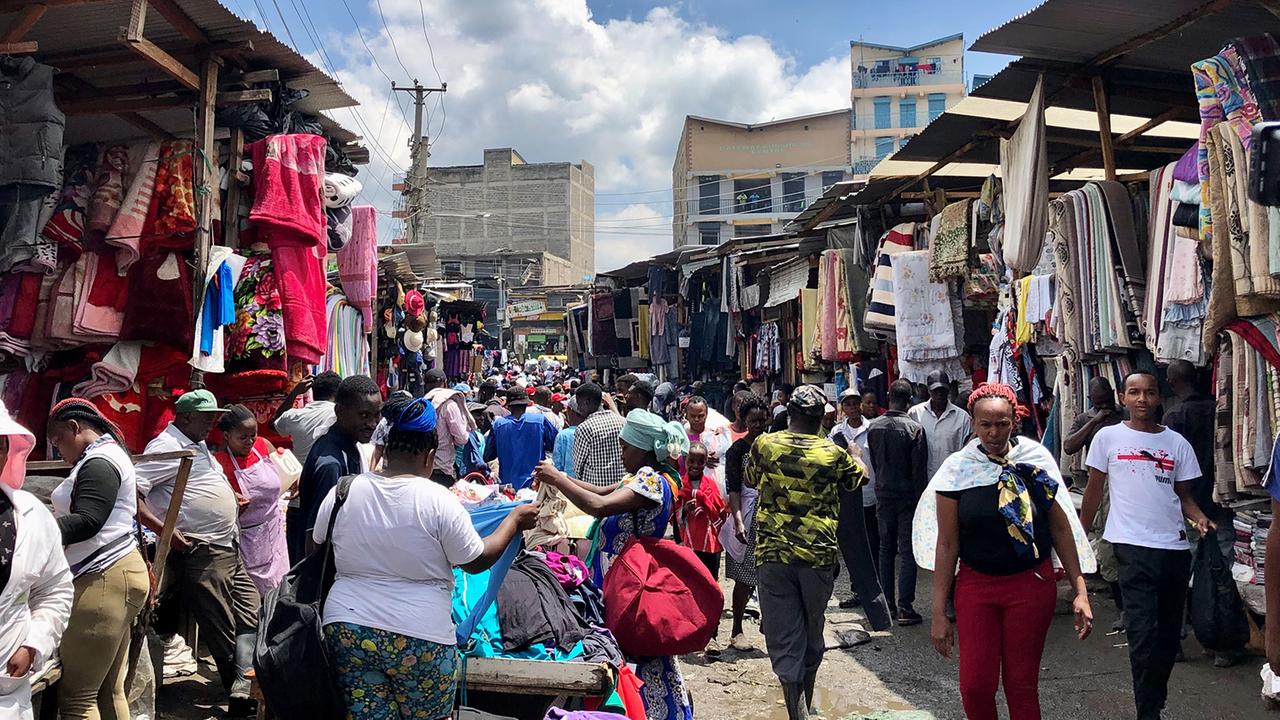Large quantities of old clothes arrive in Kenya from all over the world – including from Germany. They are a problem for the environment and the Kenyan textile industry. But they also offer opportunities.
It's colorful, loud and crowded at the Gikomba market in Nairobi. T-shirts, shirts and pants hang on wooden stands. Everything here is second hand. Gikomba is the largest second-hand clothing market in Kenya.
Thousands of customers come here every day, says Peter Wachira, general manager of the market association. Not just from Kenya, but also from neighboring countries such as Tanzania and Uganda. The Gikomba market is a magnet in East Africa for anyone looking to buy or sell used textiles. More than 100,000 retailers offer their goods here. That's as many people as live in a smaller German city.
Aloise Swaye (in the yellow shirt) has had his stall at Gikomba Market for many years.
Used t-shirt for 70 cents
One of the dealers is Aloise Swaye. He sells used T-shirts and shirts and has been working at the Gikomba market for 19 years. Aloise Swaye says he relies on second-hand clothing. He could make a good living from selling them. A T-shirt here costs 100 Kenyan shillings, the equivalent of about 70 cents.
A woman rummages through a large pile of old clothes on a wooden table in front of his market stall. Alice Mwangi is looking for shirts – not for her husband, but for her customers. She resells the shirts. The most important thing: The used textiles have to be of good quality, she says, otherwise her customers will be dissatisfied.
Nancy Ndungu's goods come from all over the world, including Germany.
Germany sells a lot of old clothes to Africa
The second-hand items at this market are not clothing donations. They come from commercial textile retailers – primarily from the USA, China and Great Britain. Also from Germany, because the country is one of the world's largest exporters of second-hand clothing. Last year, a good 430,000 tons of old clothes were sold around the world, according to market statisticians from ITC/Statista. They will initially be sold to the Netherlands and Poland. From there transported to Africa via the ports in Rotterdam and Gdansk.
The old clothes then arrive in Africa – in large bundles, wrapped in thick plastic film and tied tightly. In Kenya they are called Mitumba. In Nancy Ndungu's office, packages of clothes are piled up to the ceiling. The businesswoman says she has suppliers all over the world, including in Germany, who collect old clothes from them and then sell them to Kenya. She then sells these second-hand clothes to the traders at the Gikomba market. A long chain of dealers – from Germany to Africa.
Flood of textiles clogs rivers in Kenya
The old clothes are causing big problems in Kenya. Cheap clothes made from synthetic fibers, from so-called “fast fashion” that cannot be recycled, are clogging up rivers and polluting the landscape. There are now significantly more old clothes of poor quality that just end up in the trash, say dealers on the market. In Germany alone, according to the Federal Statistical Office, the amount of textile and clothing waste has increased by around 70 percent within ten years.
Another problem: Many jobs have been lost in the Kenyan textile industry, criticizes Whitney Speke from the recycling organization “Africa collect textiles”. Local clothing manufacturers went under because the used clothes were much cheaper. There used to be a great diversity of textile production in Kenya, says Speke. But they no longer exist.
Trading second-hand goods also offers the opportunity for many jobs.
Second hand clothing creates new jobs
But second-hand fashion also offers opportunities in Kenya. Thousands of new jobs have been created around the Gikomba market – for example in sewing rooms, laundries or transport companies. People who have little money can afford clothes here. So Mitumba is both a curse and a blessing.
Karin Bensch, ARD Nairobi, tagesschau, April 22, 2024 2:55 p.m





